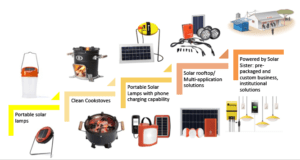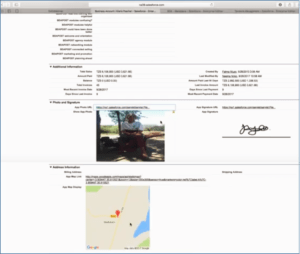
Search
As off-grid solar increases its prevalence as an energy source, companies like Solar Sister are paving the way in terms of how they think about selling and distributing affordable solar products to those that benefit from it most in the last mile. A big thank you to David, O’Connor, Solar Sister COO, for joining and sharing your insights! Read our webinar recap below, or watch the full webinar for all of the details.
Energy access is a serious challenge across Africa, with over 600M people living without access to the grid, 85% of the rural population without access to the electricity grid, and 728M people dependent on solid fuels for cooking, which are very hazardous when burned into the environment. Solar Sister operates in Tanzania, Uganda, and Nigeria, in areas characterized by low energy access.
Current solutions for energy and cooking can be costly and can compromise health and the environment. Solutions can be expensive and low quality. Health hazards include people burning charcoal in huts, which adds to indoor air pollution leading to widespread incidence of respiratory issues that disproportionately affect women and girls who are the ones cooking. Lastly, there are environment challenge from the greenhouse gas emissions from kerosene lamps.
About $18M USD are spent annually on off-grid energy solutions, of which the largest portion ($11.5M) is kerosene. A very small amount – $0.1M – is spending on pico-photovoltaic (solar), and indicates the opportunity for solar to displace the more inefficient, unhealthy, and environmentally unfriendly options.
There are knock-on effects of cooking and lighting that disproportionately affect women. A disproportionally high share of girls and young women help in household chores related to fuel collection. As a result, girls have to study after dark and are reliant on expensive, dangerous and low-quality light unless they have access to electricity or solar lights. Consequently girls and young women face a high school drop-out rate and are disadvantaged educationally and economically. Breaking this cycle is one of Solar Sister’s key focuses.
These households need a clean source of light that doesn’t compromise their health, are durable and therefore not expensive to replace, available in the last mile in terms of access and service, and are easy to use. This became the opportunity for Solar Sister, who is able to deliver on the urgency of needs, willingness to pay despite spending constraints and absence of viable alternatives.
Solar Sister provides this solution through a woman-led and women-driven last-mile distribution company, like an Avon of clean energy in Sub-Saharan Africa. Women distribute the clean energy products through their established networks because they’re often trusted nurses, teachers or stay-at-home moms. These women know the household needs, use the products themselves, and know the households personally – so it makes sense for them to be part of the distribution network.
Solar Sister focuses on the distribution part of the supply chain. They receive a range solar products from a variety of manufacturers. From the manufacturer warehouses, these products are delivered to the Solar Sisters local offices in Nigeria, Uganda and Tanzania. From these local offices, the products are delivered to Solar Sister’s remote sales agents, whose jobs are to recruit, train and support the entrepreneurs as they sell the products in their communities.

For the remote Business Development Associates (BDAs), they start the implementation cycle in a new community by:
To date, Solar Sister has over 3,000 entrepreneurs across their 3 countries, and their product sales have touched over 920,000 beneficiaries across Sub-Saharan Africa.
With so many different roles and activities, Solar Sister needed a tool to help track everything in one place. They faced a difficult situation where they had 3,000 entrepreneurs each making sales, 60-70 FT staff in remote places all over Africa that they need to communicate with and get information from. As a social enterprise that gets revenue from both sales and grants, Solar Sister needs up-to-date information about their operations to keep their business running and also to report on their grants. The system they use for managing all of this is what they call the Mobile Business Toolkit, which is comprised of Salesforce.com and TaroWorks.
2010 – Solar Sister conducts a pilot project in Uganda with a few entrepreneurs testing if the Solar Sister model would work for them.
2011 – First full-time staff was hired. At this stage of the business, all invoice and customer data was being tracked using Google Docs.
Spring 2013 – One of David’s first tasks was to move the company onto a full customer relationship management system. They decided on Salesforce.com, and worked with Tact Global, a Salesforce implementor, to set that up. At that point, they migrated over 15,000 historical records from Google Docs into Salesforce.com. For invoices, entrepreneurs were making entries via laptops and shipping paper receipts to the branch offices monthly or quarterly for auditing purposes. The system worked but wasn’t ideal because receipts were frequently damaged en route to the office, and they had to dedicate an entire room just to house the physical receipts. They started looking for a front-end system that would:
Because they were already using Salesforce.com, adding on TaroWorks was a no-brainer because it’s directly integrated with Salesforce and required the least amount of integration.
Summer 2015 – Implemented TaroWorks and had no more paper receipts!
They’re now using TaroWorks to track everything from inventory (using purchase orders for when inventory comes in, and tracking what goes out to remote staff), payments that have been received or deposited into the bank, surveys for grant requirements, and applications for new entrepreneurs.
As an example, David showcased their application form for registering new entrepreneurs, highlighting the consent form, contact information question, GPS capture, and M&E related questions. (NOTE: See the recording for David’s full demo of their entrepreneur application form and invoices on the mobile device, and how the data appears in Salesforce!). Here’s more detail about what Business Development Associates use the TaroWorks mobile app for as they register entrepreneurs:
In addition to the initial entrepreneur registration, BDAs are also using TaroWorks to log invoices. When a BDA has connectivity, they sync their logs to the database, where managers can view data at different levels:
For an individual entrepreneur, managers can see their photo, how many invoices they’ve generated over time (and drill into each for more detail), and impact survey results. A portion of an entrepreneur’s record:


At the Business Development Associate level, Solar Sister has dashboards to monitor different metrics for each BDA’s portfolio of entrepreneurs:
For the Country Managers, the information for BDAs are aggregated up 1 level to the country level. Country Managers can see results across BDAs, so they can identify those that may need more training or help.
HQ managers like David can view organization-wide information across countries. With this view, they can tell that their Tanzanian team sells higher volumes of the smaller products, whereas Uganda and Nigeria sells a lower quantity but of larger systems.
Since starting to use TaroWorks in their Salesforce system, they’ve moved to completely paperless sales tracking, saving time, physical space and being able to streamline their team. They also reduced their technology spend because they could equip staff with tablets instead of more expensive laptops.
Getting data in real-time allowed them to see patterns in their business, and helped them make the decision to change their KPIs and re-align them with both staff performance and ultimately, their mission. Originally, their main KPI was the number of recruits they brought onboard, so they focused their efforts on recruiting as many people as they could, with the assumption that more recruits would lead to more sales. As data from their system started coming in, they saw that some recruits came onboard but only bought one product before disappearing, which wasn’t helping them accomplish their mission of creating sustainable entrepreneurs. Once they saw this pattern, they focused on new metrics for the Business Development Associates to assess level of engagement of their entrepreneurs: number of active-this-month entrepreneurs and amount of sales revenue. They aligned the BDA’s incentives against these metrics, so they have a partial incentive structure where the bonus kicks in only when they have 20 or more active entrepreneurs each month, at which point they receive a percentage of the sales revenue.
The data showed that BDAs were meeting with entrepreneurs 1-on-1 or in groups of 2, which is more inefficient than larger groups. This led to decreased sales because entrepreneurs weren’t learning best practices or supporting each other. By noticing that the number of Sisterhood meetings were dropping off, they were able to emphasize it over the past 6 months and are now seeing positive results from the effort.
Solar Sister is currently working on building a website for donors and managers to using MapAnything in Salesforce to take the GPS coordinates taken using TaroWorks, and display them on their website for donors and for management. This will also help them see the concentration of entrepreneurs and what locations they should do more recruiting.
Previously, all of their impact surveys were conducted on paper. This would take several weeks of back-and-forth, account for finalizing the questions, translating into Swahili, printing in the local offices, sending out to field agents, and getting the surveys back to the field offices and into Excel. This whole process would take 3 or 4 months to get results. With TaroWorks and Salesforce, it’s just David and one other staff who meet for a few hours to finalize questions, load into TaroWorks, and wait as the responses get synced back to the system over the next few weeks. They recently finished a survey of roughly 500 entrepreneurs in 3 weeks. This this wasn’t their main reason for using TaroWorks, they were happy to see these improvements.
Having this kind of impact data has led to various M&E partnerships over the years, including with ICRW, MIT, Miller Center for Social Entrepreneurship, and the Thunderbird Emerging Markets Laboratory.
Over the years, they’ve gotten quite a few inquiries about how to build and maintain such a robust system with such a lean organization. Here are David’s best practices for implementing a robust sales operations system:
Expect to invest time into configuring your system upfront – don’t expect these kinds of systems to be plug-and-play. For a few weeks up to the first few months depending on how robust of a system you need, expect someone to spend the majority of their time getting the system up and running. For David, he spent 80% of his time on the system initially.
For Solar Sister’s staff of around 70, they have invested for 5 people across the organization to manage the system in some capacity. There are 2 people who oversee activities in the US (David and their grants person) and track to make sure data reconciles with their bank accounts. There is also 1 system administrator in each of their 3 country offices, with 50% of their time being the in-country system administrator, and 50% on inventory management. Now, David spends 10% of his time on ongoing maintenance on the system.
Be creative and think outside of the box to get the most out of the system. Solar Sister originally invested in the system for sales management and CRM, but they’ve since started using GPS for maps, conducting M&E surveys, but it was a good opportunity and it’s worked out really well.
POST TOPICS
Sign up to receive emails with TaroWorks news, industry trends and best practices.
TaroWorks, a Grameen Foundation company.
Site by V+V